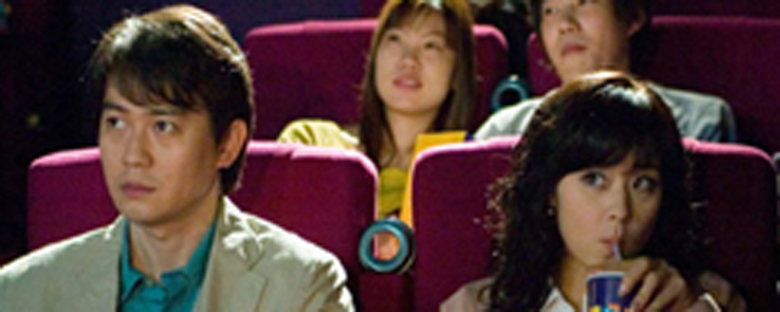Reviews
Dalkom, salbeorhan yeonin
Son Jae-Gon
South Korea, 2006
Credits
Review by Teddy Blanks
Posted on 07 September 2006
Source VHS screener
Related articles
Features: The New York Korean Film Festival
Before the many complications of its plot set in, My Scary Girl could be a kind of Korean 40 Year-Old Virgin. Its protagonist, the straight-laced professor Hwang Dae-Woo, is not merely abstinent; he has never so much as been on a date. In accordance with movie logic, he meets a too-cute girl-next-door and exposes his romantic ineptitude through a series of awkward encounters, but eventually wins her over. This is about as much plot as most American audiences can take, but director Son Jae-Gon is either trying to bust up Hollywood clichés, or he is so in love with them that he wants to shove into this story every genre, mood, or type of character he can bring to mind.
Part of the feeling that we are watching two or three different movies comes from Son’s treatment of the female object of affection: he gives the girl her own set of friends, problems, neuroses, and faults, which is something, for all its feminist posturing, Hollywood almost never does. By creating a full-fledged female character, Son shows us that the traditional romance-comedy formula doesn’t have room for one. So he expands the scope of the film and gives Lee Mi-Na her own separate plotline, too, complete with multiple murders and a fortune in inheritance (from her husband, dead of a heart attack) that all of her friends are after. As Dae-Woo slowly realizes Mi-Na is not the girl he thinks she is, the movie becomes more and more unpredictable, with extreme and sudden shifts in tone and quality. This is either a problem with the film, or what makes it so enjoyable, depending on your taste.
Dae-Woo is a genuinely funny character, a man who ignorant about love to the point of absurdity. His astonishment over the first time Mi-Na uses her tongue to kiss him lasts for days: he is shown asking a stranger, “Sir, have you ever kissed? Do you stick your tongue in the mouth when you kiss too?” Nor does he understand modern technology in the context of dating. When Mi-Na, standing next to him, dials his cell in order to give him her number, he answers saying, “I’m busy, can I call you back later?” In general, Korean filmmakers seem especially comfortable involving new technology – the way we communicate today – in the everyday lives of their characters. There are more than a few quips about the internet’s effect on modern romance. In one scene, a hustler beats down one of his henchmen, asking “Why did you brush me off on the web?”
My Scary Girl had an incredibly low budget, partially financed by a television station, was shot in HD video (though it looks like film), but was nonetheless a hit at the Korean box office. In America, we have Soderbergh and HDNet exploring these kinds of alternate financing/new technology opportunities, but Bubble, despite being one of the best American movies released this year, didn’t have the mass appeal to be truly successful. My Scary Girl isn’t an art film; it’s a twisted, complex piece of popular entertainment. Maybe it is something similarly weird and fun that will break the HD barrier in the West, and finally make this cheap technology a lucrative and viable moviemaking option.
We don’t do comments anymore, but you may contact us here or find us on Twitter or Facebook.



